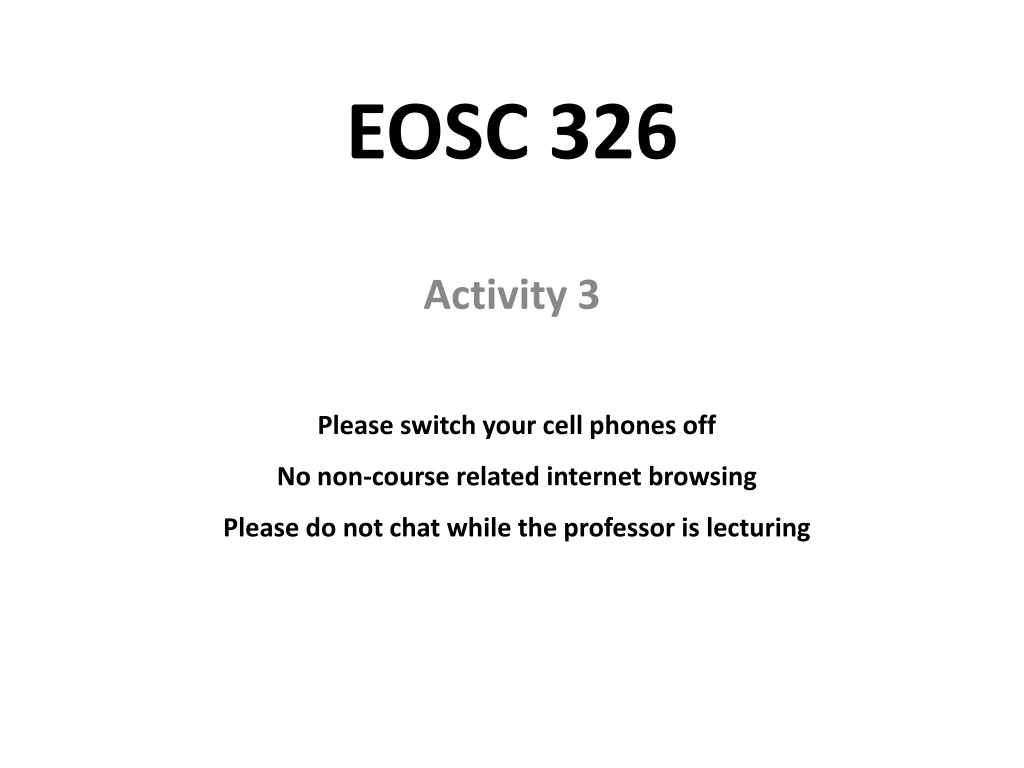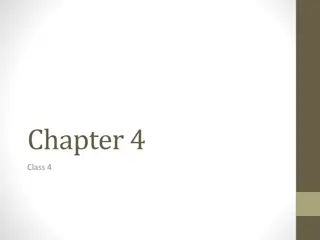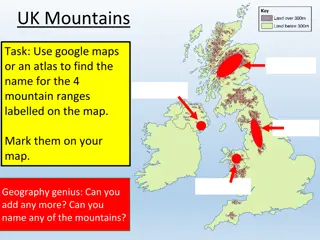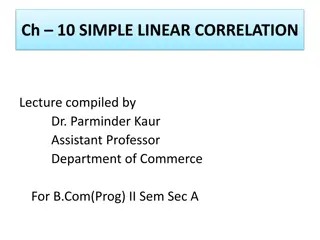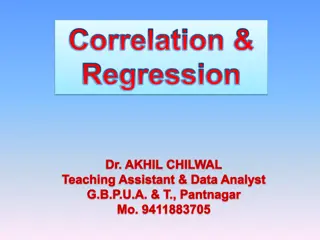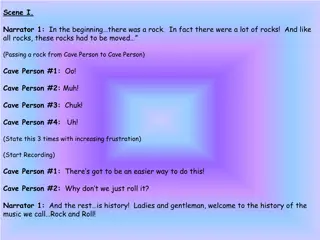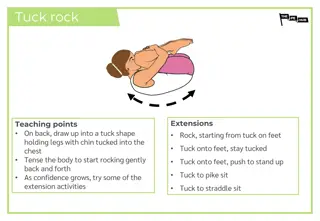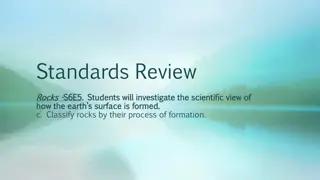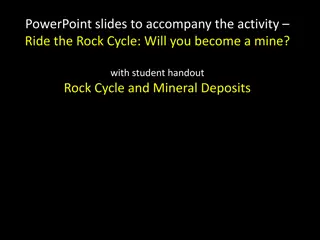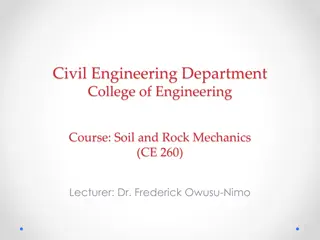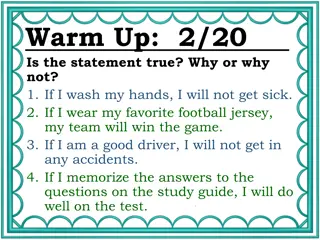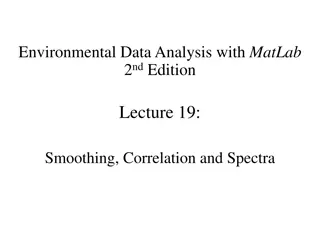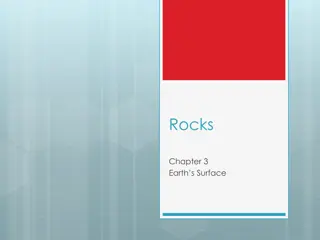Understanding Rock Correlation Through Facies and Biostratigraphy
Explore the correlation of rocks using facies and biostratigraphy in Activity 3 of EOSC 326. Learn about constructing biozones, correlating stratigraphic logs, and interpreting paleoenvironments. Discover the significance of fossils B and F in correlation and apply techniques like seriation in constructing biozones. Engage in a hands-on exercise to describe a biozone for fossil B using base of range techniques. Participate in interactive clicker reviews to test your knowledge on seriation and the additional information needed to construct a base of range biozone for fossil B.
Download Presentation

Please find below an Image/Link to download the presentation.
The content on the website is provided AS IS for your information and personal use only. It may not be sold, licensed, or shared on other websites without obtaining consent from the author. Download presentation by click this link. If you encounter any issues during the download, it is possible that the publisher has removed the file from their server.
E N D
Presentation Transcript
EOSC 326 Activity 3 Please switch your cell phones off No non-course related internet browsing Please do not chat while the professor is lecturing
ACTIVITY 3 Purpose 1. To explore how we can correlate rocks using facies and biostratigraphy. Progression 1. Construction of biozones 2. Correlation of several stratigraphic logs using sedimentary facies and fossils 3. Paleoenvironmental interpretation of a geological horizon
A B C D E F G H I J Fossil B and F are known to be useful fossils for correlation over a wide area. On the work sheet provided construct AND describe a biozone for B using base of range techniques make sure you apply seriation first.
i>clicker: REVIEW: what is Seriation? A. Placing fossils with the shortest range first B. Placing fossils with the longest range first C. Placing fossils that are least facies dependent first D. Placing fossils in stratigraphic order E. Placing fossils in paleonenvironmental order Strategy: Solo quick vocabulary check
A B C D E F G H I J Fossil B and F are known to be useful fossils for correlation over a wide area. On the work sheet provided construct AND describe a biozone for B using base of range techniques make sure you apply seriation first.
Exercise 3, part 1 Stu. IDs: 1________ 2 ________ 3 ________ 4 ________ 5 ________ 6 ________ 7 ________ Fossil B and F are known to be useful fossils for correlation over a wide area. On the work sheet provided construct AND describe a biozone for B using base of range techniques make sure you apply seriation first. Biozone Description:
i>clicker: To construct a base of range biozone for B, what extra information do you need ? A. The abundance of the fossil through time B. An understanding of the environment the creature lived in C. Radiometric dates associated with the range of fossil B D. Radiometric dates associated with the range of fossil F E. Do not need any extra information - Solo first - Peer discussion, then revote.
i>clicker: To construct a base of range biozone for B, what extra information do you need ? A. The abundance of the fossil through time B. An understanding of the environment the creature lived in C. Radiometric dates associated with the range of fossil B D. Radiometric dates associated with the range of fossil F E. Do not need any extra information Strategy: Hardish question: - Solo first - Peer discussion, then revote.
E C G B J H D A F I Seriation applied Strategy: - Now define the biozones (~1/2 minute to see what they are thinking) - Check via next slide
Biozone F Biozone B Biozone Undefined E C G B J H D A F I Define Biozones: Strategy: - Now write the biozone description, incorporating all fossils into the description.
Biozone F Biozone B Biozone Undefined E C G B J D A I H F Biozone Description: Biozone B is defined at its base by fossil B and it s top defined by the appearance of Fossil F (which defines the base of the following biozone). Biozone B is also characerized by fossil C and G both of which range below and above biozone B. Fossil E ranges into biozone B from the biozone below. Fossil H ranges within Biozone B and fossils J, D and A are present in biozone B but range into biozone F.
Exercise 3, part 2 6 7 WEST Red Lion Fm. 5 Red Lion Fm. Red Lion Fm. Park Shale Park Shale Park Shale FOSSIL X FOSSIL X FOSSIL X FOSSIL X FOSSIL X Meagher Limestone FOSSIL X Park Shale pinches out Wolsey Wolsey Wolsey Shale Shale Shale Flathead Quartzite Flathead Quartzite FOSSIL B from part 1 Flathead Quartzite 1) Correlate the lithostratigraphic formations from log 4 through 5, 6 and 7 2) Note lowest 3 formations in logs 1 4. Do they indicate transgression or regression? Why? ... 5 6 7 Location of Carbonates Logs 1 7 in Montana 3) During the time of deposition of these sediments, is which direction do you think in landward? East or West? Explain why. 4) Why do you think the Hasmark Formation thins eastward? 5) Compared to Fossil B (from the previous part of the exercise) would fossil X be useful in chronostratigraphic correlation? Explain why. 6) On the next sheet: Draw a cross section of the sedimentary environment that might have existed at the time indicated by the base line fossil B (Glossopleura). If you can, indicate the position of the logs, facies and stratigraphic formations.
Exercise 3, part 3 6 7 WEST Red Lion Fm. 5 Red Lion Fm. Red Lion Fm. Park Shale Park Shale Park Shale FOSSIL X FOSSIL X FOSSIL X FOSSIL X FOSSIL X Meagher Limestone FOSSIL X Park Shale pinches out Wolsey Wolsey Wolsey Shale Shale Shale Flathead Quartzite Flathead Quartzite FOSSIL B from part 1 Flathead Quartzite
i>clicker: Consider the stratigraphic logs and your paleoenvironmental interpretation. What would happen to a potential shoreline on your reconstruction if you run the geological clock forward? - Solo question - NO ANSWER A. It would move East B. It would move West C. It would stay in the same location D. There is not enough information available to tell 6 7 WEST Red Lion Fm. 5 Red Lion Fm. Red Lion Fm. Park Shale Park Shale Park Shale FOSSIL X FOSSIL X FOSSIL X FOSSIL X FOSSIL X Meagher Limestone FOSSIL X Park Shale pinches out Wolsey Wolsey Wolsey Shale Shale Shale Flathead Quartzite Flathead Quartzite FOSSIL B from part 1 Flathead Quartzite
i>clicker: How can you predict which way the shoreline will move? A. The logs indicate that sea level is rising B. The logs indicate that sea level is falling C. Fossil X is found in the Park Shale D. Fossil B is found in three different formations - Solo question - NO ANSWER 6 7 WEST Red Lion Fm. 5 Red Lion Fm. Red Lion Fm. Park Shale Park Shale Park Shale FOSSIL X FOSSIL X FOSSIL X FOSSIL X FOSSIL X Meagher Limestone FOSSIL X Park Shale pinches out Wolsey Wolsey Wolsey Shale Shale Shale Flathead Quartzite Flathead Quartzite FOSSIL B from part 1 Flathead Quartzite
i>clicker: Consider the stratigraphic logs and your paleoenvironmental interpretation. What would happen to a potential shoreline on your reconstruction if you run the geological clock forward? Repeated question - Peers discuss A. It would move East B. It would move West C. It would stay in the same location D. There is not enough information available to tell 6 7 WEST Red Lion Fm. 5 Red Lion Fm. Red Lion Fm. Park Shale Park Shale Park Shale FOSSIL X FOSSIL X FOSSIL X FOSSIL X FOSSIL X Meagher Limestone FOSSIL X Park Shale pinches out Wolsey Wolsey Wolsey Shale Shale Shale Flathead Quartzite Flathead Quartzite FOSSIL B from part 1 Flathead Quartzite
i>clicker: If you want to study the movement of ONE facies over time, which of the following fossils mentioned in this exercise (including part 1) would be the best fossil to use? Solo only - NO ANSWER A. Fossil B B. Fossil F C. Fossil X D. None 6 7 WEST Red Lion Fm. 5 Red Lion Fm. Red Lion Fm. Park Shale Park Shale Park Shale FOSSIL X FOSSIL X FOSSIL X FOSSIL X FOSSIL X Meagher Limestone FOSSIL X Park Shale pinches out Wolsey Wolsey Wolsey Shale Shale Shale Flathead Quartzite Flathead Quartzite FOSSIL B from part 1 Flathead Quartzite
i>clicker: what criteria are you using to choose a fossil that can identify a particular paleoenvironment? A. It is stratigraphically higher than others B. It is stratigraphically lower than others C. It occurs in a wide number of facies D. It is tied to a particular facies E. It evolved rapidly 6 7 WEST Red Lion Fm. 5 Red Lion Fm. Red Lion Fm. Park Shale Park Shale Park Shale FOSSIL X FOSSIL X FOSSIL X FOSSIL X FOSSIL X Meagher Limestone FOSSIL X Park Shale pinches out Wolsey Wolsey Wolsey Shale Shale Shale Flathead Quartzite Flathead Quartzite FOSSIL B from part 1 Flathead Quartzite
i>clicker: If you want to study the movement of ONE facies over time, which of the following fossils mentioned in this exercise (including part 1) would be the best fossil to use? Peers discuss! A. Fossil B B. Fossil F C. Fossil X D. None 6 7 WEST Red Lion Fm. 5 Red Lion Fm. Red Lion Fm. Park Shale Park Shale Park Shale FOSSIL X FOSSIL X FOSSIL X FOSSIL X FOSSIL X Meagher Limestone FOSSIL X Park Shale pinches out Wolsey Wolsey Wolsey Shale Shale Shale Flathead Quartzite Flathead Quartzite FOSSIL B from part 1 Flathead Quartzite
